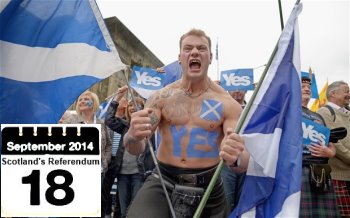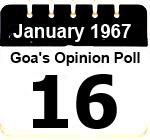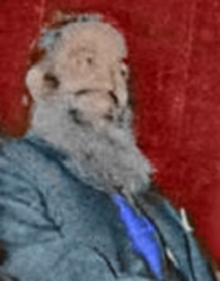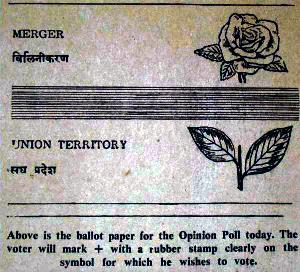A tale of two referendums
 Today, the Scots will be using the power of a ballot referendum to answer the question: Should Scotland be an independent country? If more of them say “No” then Scotland will continue to be a part of the United Kingdom. But if the majority vote “Yes” then this would bring the curtain down on a political union that has continued for over three hundred years.
Today, the Scots will be using the power of a ballot referendum to answer the question: Should Scotland be an independent country? If more of them say “No” then Scotland will continue to be a part of the United Kingdom. But if the majority vote “Yes” then this would bring the curtain down on a political union that has continued for over three hundred years.
In India, we did have two relatively small referendums in the recent past. Last year, people living in 12 villages located in the forested hillsides of Orissa opposed a mining project which was due to come up there. Before that, in 2008 farmers in 22 villages in Maharashtra opposed the acquisition of their land for a SEZ project the chief promoter of which was Mukesh Ambani.
 But the mother of all referendums so far in independent India was the one held in Goa. Yes Goa had a tryst with a historic referendum, erroneously called an Opinion Poll, in 1967.
But the mother of all referendums so far in independent India was the one held in Goa. Yes Goa had a tryst with a historic referendum, erroneously called an Opinion Poll, in 1967.
Goa’s ‘Opinion Poll’ was not like the ones we have prior to elections to find out who will make a better Prime Minister, etc. These are just that – the opinion of the people – and have no significance beyond that.
In contrast, the results of Goa’s Opinion Poll had to be compulsorily accepted by the Government of India. Moreover, Goa’s very existence as a separate entity and the identity of the Goan people was at stake. That was why its outcome was as critical for Goans then as the result of the current one is for the Scots today.
So what is a referendum?
Most of the laws or legislatures in democracies across the world are made through representative democracy, that is, our elected representatives vote on our behalf for passing or rejecting different law-making proposals. But a referendum, being an instrument of direct democracy, enables the entire electorate (instead of just their representatives) to have their say on policy issues.
Merger with Maharashtra or status quo as a Union Territory?
Goa being an acquired territory, it was not made a separate state right away. Instead, it was given the status of a Union Territory.
In 1963, the then Prime minister Jawaharlal Nehru promised that Goa would remain a Union Territory for ten years, and that thereafter the people of Goa would have the right to decide its future.
Though a Union Territory, Goa was allowed to have its own Legislative Assembly. In the first elections held at the end of 1963, Dayanand Bandodkar’s Maharashtrawadi Gomantak Party (Pro-Maharashtra Goan Party) won a simple majority securing 16 seats as against the 12 seats won by Dr. Jack Sequeira’s United Goans Party.
Buoyed up by his party’s victory, Bandodkar, Goa’s first Chief Minister insisted that the vote for MGP was a vote in favour of merger with Maharashtra. He and his party were in no mood to wait for 10 years to decide Goa’s fate. So Bandodkar declared that the matter could be decided in a few weeks by passing a bill in the Legislative Assembly.
 But Dr. Jack Sequeira or Jak Siker as he was popularly called, knew that merger would be unavoidable if this was put to the vote since MGP had more seats in the Goa Assembly than his party. Another interesting side to the issue of merger was that it also had a language connection. Though all Goans spoke their mother tongue Konkani, many of them, mostly Hindu Goans, spoke both Konkani and Marathi. Most of these Goans supported the MGP and many even incorrectly assumed that Konkani was just a dialect of Marathi.
But Dr. Jack Sequeira or Jak Siker as he was popularly called, knew that merger would be unavoidable if this was put to the vote since MGP had more seats in the Goa Assembly than his party. Another interesting side to the issue of merger was that it also had a language connection. Though all Goans spoke their mother tongue Konkani, many of them, mostly Hindu Goans, spoke both Konkani and Marathi. Most of these Goans supported the MGP and many even incorrectly assumed that Konkani was just a dialect of Marathi.
Sequeira knew that though Bandodkar and even the then Chief Minister of Maharashtra, Vasantrao Naik, had promised that Goans would be given special concessions and privileges after merger, Goa would actually end up being one of the minor districts of the much larger neighbouring state. Not just that, Konkani which could not develop and flourish under the Portuguese, would be further throttled after the merger, and in addition to losing their unique identity, Goans would even end up being passed over for jobs in their own home state.
So accompanied by a few of his MLAs, Dr. Sequeira made a dash to New Delhi to convince Nehru that a crucial decision like the future of Goa had to be decided by the people directly and only a referendum could reveal their true wishes. Freedom fighter and politician Purushottam Kakodkar (father of the noted nuclear scientist Anil Kakodkar) also joined him in making a passionate argument for a referendum in Goa.
After Nehru’s death Dr. Sequeira met Lal Bahadur Shastri, the next PM, to persuade him regarding the need for a referendum in Goa. Following Shastri’s sudden death in Tashkent in 1966, he had a meeting with Indira Gandhi as well who then had the issue discussed in Parliament. Consequently, it was decided that Goa would have a referendum by secret ballot on 16 January, 1967.
But fearing that Bandodkar would misuse the state machinery to exert pressure on the anti-mergerists, the UGP demanded that the Assembly be dissolved so that the referendum could be held under free and fair conditions. The Central Government agreed to this as the demand was justified.
The exciting run-up to the 1967 Goa Opinion Poll
Sequeira and his party were not the only ones to fight tooth and nail against the merger. For example, the industrialist V. M. Salgaocar, believing that their mother tongue Konkani could unite the Hindus and Catholics of Goa, not only funded the Konkani movement, but also started the Marathi daily Rashtramat with Chandrakant Keni as its Editor to influence Marathi-speaking Goans against the merger.
Goa’s poets, musicians, singers, and tiatrists too jumped onto the campaigning bandwagon and wielded their talents like weapons to pitch for an independent identity for their beloved Goa. Tiatrists like M. Boyer, M. Dod de Verna, and the Trio Kings Conception-Nelson-Anthony, celebrated poets like Bakibab Borkar and Dr. Manohar Rai Sardesai, Advocate, writer and lyricist Uday Bhembre, and composer-singer Ulhas Buyao, and hundreds of other Goans worked tirelessly to fortify the anti-merger campaign.
Through his sizzling, no-nonsense column Brahmastra, Uday Bhembre boldly took an opposite stance to that of his own father, the noted freedom fighter Laxmikant Bhembre. He went so far as to compare his father’s justification of the merger of Goa with Maharashtra to the justification of the Portuguese for ruling over Goa!
Ulhas Buyao, with able support from Manoharbab, Shankar Bhandari, Uday Bhembre, and his entire cultural troupe, put up around 75 performances across Goa to endorse non-merger. Two of Buyao’s most popular songs were the scintillating Chan’neache Rati (On a moonlit night) with lyrics by Bhembre, and Goenchea Mhojea Goenkarano (My fellow Goans) with lyrics by Dr. Sardesai.
Rallies, public performances of songs and skits, sloganeering, the campaigning hungama from both sides included all this and more. While the pro-mergerists thundered “Zhalach pahije“, the anti-mergerists countered them with their punch line “Amcam naca shrikhand puri, amcam zai xit-koddi“.
A flower vs two leaves
 Under the historic referendum, people had to choose between Goa remaining a Union Territory and its merger with Maharashtra. The two symbols were a flower for MGP, and two leaves (don pannam) for UGP.
Under the historic referendum, people had to choose between Goa remaining a Union Territory and its merger with Maharashtra. The two symbols were a flower for MGP, and two leaves (don pannam) for UGP.
Assuming that all those who had voted them to power would vote pro-merger, MGP got a rude wake-up call when a large chunk of their supporters, mainly upper-caste Hindus, joined the Catholics in voting for anti-merger.
Following a whopping 82% voter turn-out, 317,633 votes were polled, and ‘two leaves’ won by a margin of over 34,000 votes. Goa then went on to become the smallest state of the Indian Union in 1987, and five years later Konkani was given her rightful place amongst one of India’s national languages. Each year, Goa observes 16 January as Asmitai Dis (Identity Day). The rest is history.
Coming back to the Scottish referendum for independence, it was marked by equally action-packed campaigning by both sides. And in all probability it’s likely to spur on a staggering percentage of the electorate to go out and vote just as in the case of Goa’s 1967 Opinion Poll.
Now here’s a treat for you. Listen to Buyao’s melodious Chan’neache raati:
And an interesting connection.
Pay close attention to this song Chunari Chunari by music director Anu Malik from the Hindi film Biwi No. 1. Yes, the chorus of this song to which Salman Khan and Sushmita Sen are dancing is copied from Buyao’s song! Check it out:
Viva Goa!

Hi Veena,
Very informative and well written article on the merger.
Check out my page on Facebook: Ferraodesigns.
Regards,
Angela
Thanks for the appreciation Angela. Sure, I will check out your page.
Thanks for such interesting information 🙂
You’re welcome, Rajas.
Wow! Good to know about all of this in more detail. It was very informative. Lovely post.
Thanks for appreciating the post Nattyson.
A very, very informative article, Veena..you’ve summed this up pretty well! Must have knowledge for a true-blooded Goan, thx so much!
Thanks for the very generous compliment, Elliot.
One most influential propaganda against the merger was the fact that the Goans were told that merger would bring a ban on wine 🍷 as at the time Maharashtra had banned sale and consumption of liquor, which Goans would never agree to!
I agree Goans would never agree to prohibition. And propaganda both true and false does influence decisions, Dilip. But ultimately people give the most importance to the things that matte. In this case, the Goan identity – Goencarponn.
Hi Veena
While I am not a fan of Maharashtra politics myself, I don’t understand why गोंयकरपण is that much special than other sub-identities within Maharashtra-related (southern Indo-Aryan/Maharashtri Prakrit) cultures. Districts within Maharashtra have their own identities. State is spread from Nagpur to Raigad. There are many dialects of Marathi & they coexist.
Tell me honestly, which is the closest language to yours? My point is, while it is great that Goa decided to preserve their identity, why not have special relations between Maharashtra & Goa due to similar cultures & language?
Maharashtrians, unlike Kannadigas are welcoming of other languages. Karnataka government is hellbent on wiping Konkani in Karwar, Uttar Kinara etc districts. They already did that to Marathi in Belgaum.
A special interest corridor between Marathi & Coastal governmenta would benefit both. For your reference, here is an article from a Marathi website which praises Konkani. https://www.maayboli.com/node/23983
I support Konkani’s own identity but I just don’t like when it comes at the cost of undermining language & culture it shares so much history with.
Hi Ekdant! I appreciate your expressing your views on several issues. But I need to make a few clarifications. My article is just a recounting of a historic event in the history of the state of Goa. In no way have I endorsed the undermining of any other language. While one’s own mother tongue, like Konkani is for Goans and Marathi is for Maharashtrians, will naturally hold a special place in the hearts of the people of different communities, in my view no one language can be considered superior to any other for all languages are just a means for humans to communicate with each other. And as instruments of communication, we need to respect all languages. I myself am proud of and love my mother tongue Konkani, but I am also fond of Marathi and read and enjoy reading Marathi literature and listening to Marathi music. So Goans holding fast to their special love for their mother tongue Konkani should not be interpreted as their having no appreciation of other languages, closer to Konkani or otherwise. Also, if Goykarpann is greatly valued by Goans, that is but natural. For Goans goykarpann will always be special just as the people of Maharashtra will always value their Marathi asmita. Let us not look at the appreciation of their identities and unique culture by different communities as a sign of looking down on the identities and cultures of other communities. I hope you will agree with me on this. Best wishes and thanks for getting in touch.
This is a treasure trove of information for me as a quizzer. Thank you so much !
Glad you found the post useful, Prathmesh.